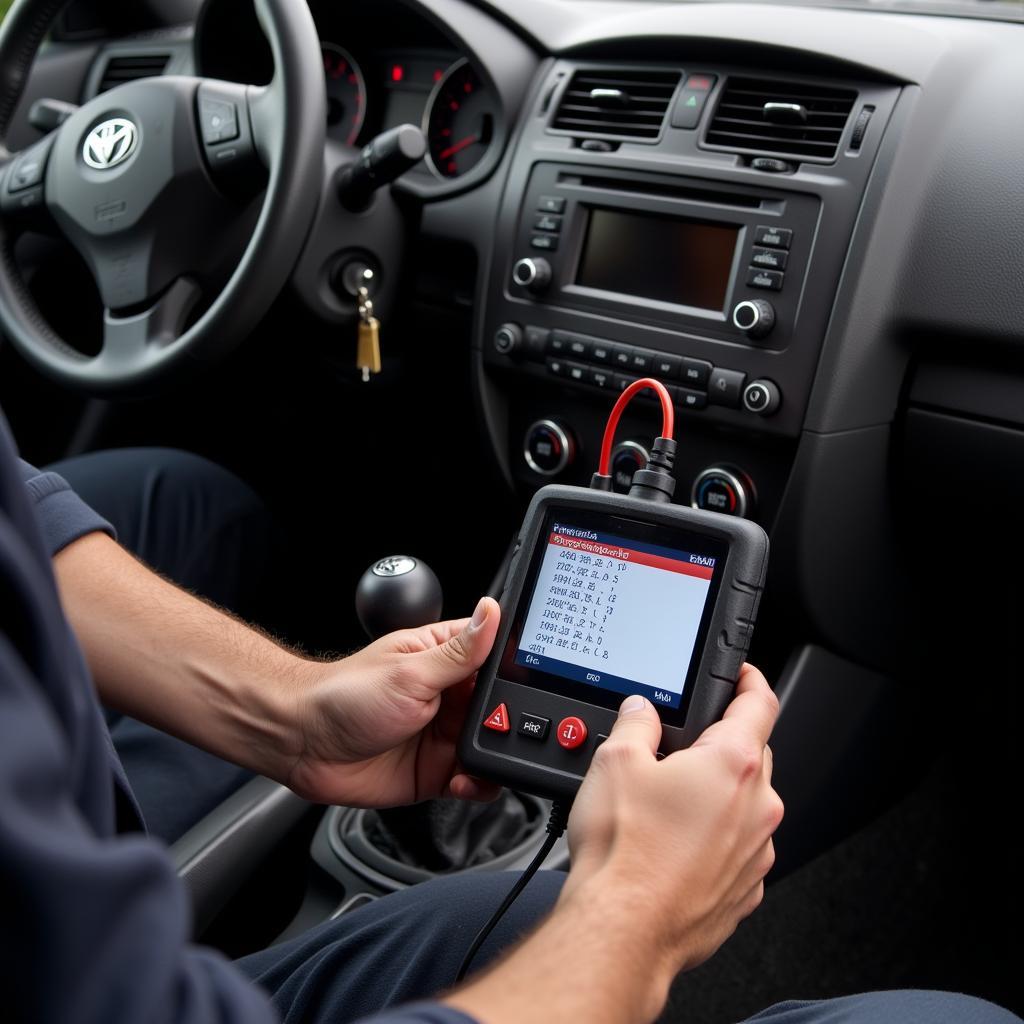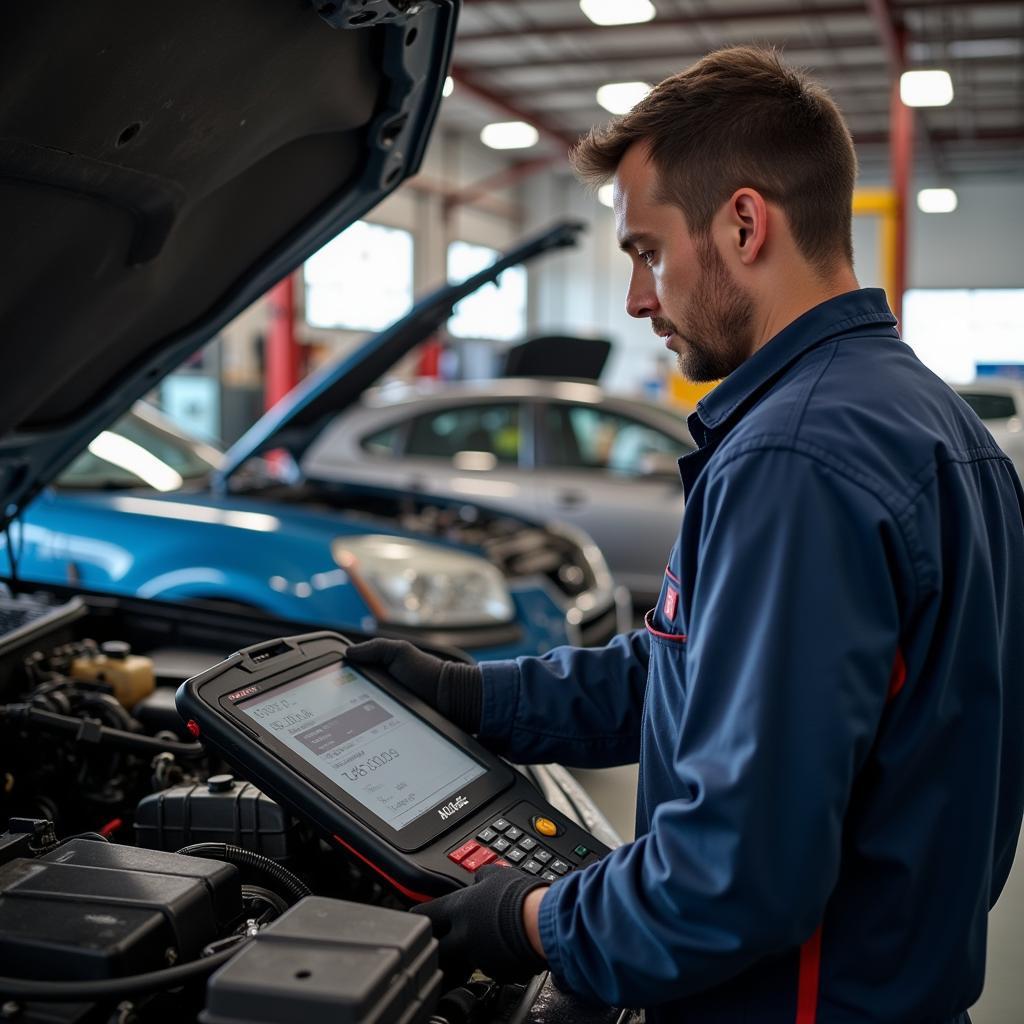The automotive industry is rapidly evolving, and with it, the tools used for diagnostics and repair are becoming increasingly sophisticated. This often leaves car owners, repair shops, and even seasoned technicians grappling with complex vehicle issues. While new diagnostic tools offer the latest technology, their hefty price tags can be a deterrent. This is where Second Hand Diagnostic Tools come in, offering a cost-effective solution without compromising functionality. This comprehensive guide will delve into the world of second hand diagnostic tools, equipping you with the knowledge to make informed decisions for your automotive needs.
 Inspecting a Second Hand Diagnostic Tool
Inspecting a Second Hand Diagnostic Tool
Why Consider Second Hand Diagnostic Tools?
The most compelling reason to consider second hand diagnostic tools is the significant cost saving. Brand new, high-end diagnostic tools can cost thousands of dollars, putting a strain on budgets, especially for start-up businesses or individual car owners. Purchasing a pre-owned tool allows you to access advanced features and capabilities at a fraction of the original price. This allows you to allocate your budget effectively, investing in other essential equipment or services.
Navigating the Used Diagnostic Tool Market
While the allure of affordability is undeniable, navigating the used diagnostic tool market requires careful consideration.
1. Determine Your Needs
Before diving into the vast sea of options, clearly define your diagnostic needs. What make and model of vehicles do you typically work on? What systems and functionalities are essential for your diagnostic procedures? Understanding your specific requirements will help you narrow down your search and choose a tool that aligns with your needs.
2. Research and Compare
Just like buying any used equipment, thorough research is crucial. Explore different brands and models, comparing their features, functionalities, and compatibility with your vehicles. Look for tools that support the protocols and systems you frequently encounter in your diagnostic work.
 Researching Diagnostic Tools Online
Researching Diagnostic Tools Online
3. Check for Updates and Compatibility
Diagnostic software is continuously updated to accommodate new vehicle models and technologies. When considering a second hand tool, ensure it’s compatible with the latest software updates and that the seller provides necessary cables and adapters. Contacting the manufacturer directly can provide clarity on update availability and compatibility with your target vehicles.
4. Inspect Thoroughly
Don’t solely rely on online descriptions and photos. If possible, physically inspect the tool before purchasing. Look for any signs of wear and tear, damage to cables or connectors, and ensure the screen is functioning correctly. If purchasing online, choose reputable sellers who offer detailed descriptions, clear images, and preferably, a return policy.
 Testing Diagnostic Tool Functionality
Testing Diagnostic Tool Functionality
Making an Informed Purchase
Buying second hand diagnostic tools can be a smart investment if you approach it strategically.
- Choose reputable sellers: Opt for established online marketplaces, specialized forums, or local automotive tool suppliers known for their credibility.
- Ask questions: Don’t hesitate to inquire about the tool’s history, usage, and reason for selling.
- Negotiate the price: Be prepared to negotiate a fair price, especially if you identify any minor cosmetic imperfections.
- Verify functionality: Before finalizing the purchase, ensure the tool powers on, connects to a vehicle’s diagnostic port, and retrieves data without any issues.
Maintaining Your Second Hand Diagnostic Tool
Once you’ve acquired your second hand diagnostic tool, proper maintenance can extend its lifespan and ensure optimal performance.
- Keep it updated: Regularly check for and install software updates to stay compatible with the latest vehicle models and technologies.
- Handle with care: Avoid dropping or mishandling the tool to prevent physical damage.
- Store properly: Store the tool in a clean, dry environment when not in use to protect it from dust, moisture, and extreme temperatures.
 Mechanic Using a Diagnostic Tool in a Workshop
Mechanic Using a Diagnostic Tool in a Workshop
Conclusion
Investing in second hand diagnostic tools can be a wise decision for both professionals and car enthusiasts looking to save money without compromising on quality. By thoroughly researching, carefully inspecting, and performing due diligence, you can acquire a reliable tool that meets your diagnostic needs. Remember, a well-maintained diagnostic tool is an investment that can pay off for years to come.
Need help choosing the right second hand diagnostic tool? Our team at ScanToolUS is here to assist you. Contact us at +1 (641) 206-8880 or visit our office at 1615 S Laramie Ave, Cicero, IL 60804, USA.
We can help you explore options like a 1991 Land Cruiser diagnostic tool, learn if you can i remove windows media diagnostic tool, or understand how diagnostic tools save session. Our team can also help you find the perfect OBDII/EOBD car diagnostic tool or discuss a vehicle diagnostic tool with fix assist.


